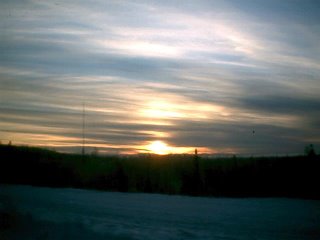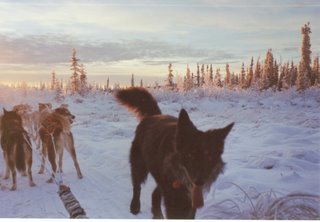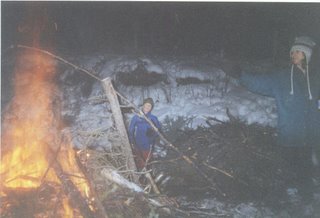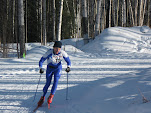Lights Within the Tunnel
 That is the most frequent question asked by people from the lower 48 to Alaskans. The image held by many is 20-24 hours of darkness a day. Unless you're well above the Arctic Circle, a claim that only a few thousand Alaskans can make, it isn't quite that dark. For example, Fairbanks only has only three hours and forty two minutes of daylight on the shortest day, but with the low angle of the sun there is a lingering morning and evening twilight, which adds nearly three hours of light. So if you want to get technical, our nights are only 17.5 hours. Nevertheless, that's a long night, because anything over 15 or 16 hours seems quite long.
That is the most frequent question asked by people from the lower 48 to Alaskans. The image held by many is 20-24 hours of darkness a day. Unless you're well above the Arctic Circle, a claim that only a few thousand Alaskans can make, it isn't quite that dark. For example, Fairbanks only has only three hours and forty two minutes of daylight on the shortest day, but with the low angle of the sun there is a lingering morning and evening twilight, which adds nearly three hours of light. So if you want to get technical, our nights are only 17.5 hours. Nevertheless, that's a long night, because anything over 15 or 16 hours seems quite long.Now into our third winter in Alaska, here are some ways that we have used to adapt to the short-days and long nights.
Full spectrum lighting -- If you can't find it naturally, then fake it. The bulbs are quite expensive, about $25 or $30 each, but they put out a white light that mimics natural light 95% to 97%. This makes a huge difference over conventional incandescent lights. We didn't use full spectrum lights until after Christmas 2004, when we found that getting up in the morning was extremely difficult, and we were always tired and lethagic in the evening, unable to concentrate on anything. The kids were disoriented and would stay up late only to wake up frequently, not knowing when they should get up in the morning. We bought five bulbs for the house and use them in key areas such as the dining room, study, and bedrooms. We noticed an imediate improvement, and the energy saving lights have lasted two years already.
Get outside at mid-day -- Provided that you have a lunch break or some flexibility, just getting outside for a bit between 11:30 and 1:30 can also help tremendously. From early December through mid-January I will either schedule a ski or run at that time, or if things are too busy, I'll go for a short walk outside, even if it's -30 F! Ten or fifteen minutes will do. I also try to work in any errands so I can get outside and into what light there is, if not for a few minutes.
Ignite the fire within -- Find a winter passion, preferably outside, and stoke the flame. I love cross country skiing and ski racing; ample skiing was a big incentive to move here. Throughout the winter I'm always preparing for the next set of races or just getting out for 45-60 minutes to enjoy the day. It doesn't matter if you're out at mid-day or at night under the lights, simply getting outside to burn some energy is what makes winter here great. For others, mushing fuels the passion for winter. A hard-core running group is outside a good 350 days a year, disdaining the indoor track or a treadmill. Ice fishing, snow machining, and bird watching are popular weekend activities. Just getting outside, doing something you love to do, is usually enough to drive away any winter blahs.

Recycled sunlight -- Combusting the stored end products of photosythesis is a great way to break up the long winter night. Last year we needed to thin out our woodlot for a State sponsored fire prevention program. I cut dozens of trees and we piled up several cords of wood and slash. Perfect for a mid-winter bonfire. Invite some friends and you have a party, and nothing beats tending to a warm blaze, with mesmerizing embers glowing mystically into the sub-Arctic night.
Taking in the night -- Okay, it's below zero and it's dark three-fourths of the time, but with snow cover a moonlit night is almost as bright as late twilight. Moonlight ski outings or mushing parties give a great excuse to go out at night with friends. When it's clear at night, about half the time, the stars here are very bright. Weird though, to see Alaska's iconic Big Dipper behind you, to the south, and the North Star? It's right above your head, its angle of sight leading just a few degrees north. The best, however, is the aurora borealis, which is usually active several nights a week. Caused by ions in the upper atmosphere that originated from solar flares a few days earlier, the aurora can be enough to stop traffic--even among the most seasoned Alaskans. More than 100 miles up, sometimes expanding across the entire northern horizon, the aurora dances, a diffuse ionic curtain that drifts as a surrealistic ribbon of faint light. It's usually green with a hint of purple on the margin, but on a good night you can see red and pink.
The best, however, is the aurora borealis, which is usually active several nights a week. Caused by ions in the upper atmosphere that originated from solar flares a few days earlier, the aurora can be enough to stop traffic--even among the most seasoned Alaskans. More than 100 miles up, sometimes expanding across the entire northern horizon, the aurora dances, a diffuse ionic curtain that drifts as a surrealistic ribbon of faint light. It's usually green with a hint of purple on the margin, but on a good night you can see red and pink.
Go with flow of change -- One of the first things you would notice here if you stayed more than a couple of weeks is how fast the light conditions change. At the winter solstice, the train of light slows and slows until we reach a dimness which nearly stops in the tunnel. Today, December 22, we gained one second of light, tomorrow it will be fifteen seconds. By New Year's we'll get two minutes more daylight, and by Ground Hog's day, the length of daylight will have doubled, and we'll be gaining more than five minutes a day.
So, indeed there is a light challenge here--out of lux, if you will. But within weeks this too shall pass, as we head into February and March, two of the best non-summer months of the year.
(Photos by Mikko Sayre)



0 Comments:
Post a Comment
Subscribe to Post Comments [Atom]
<< Home